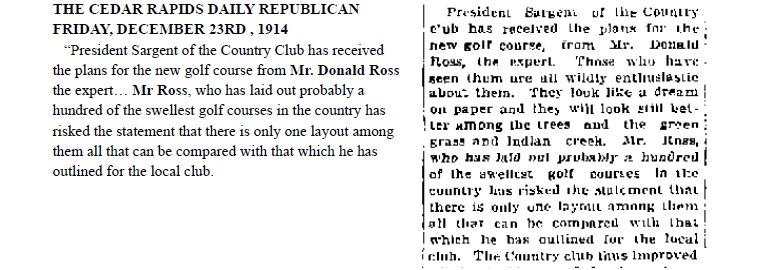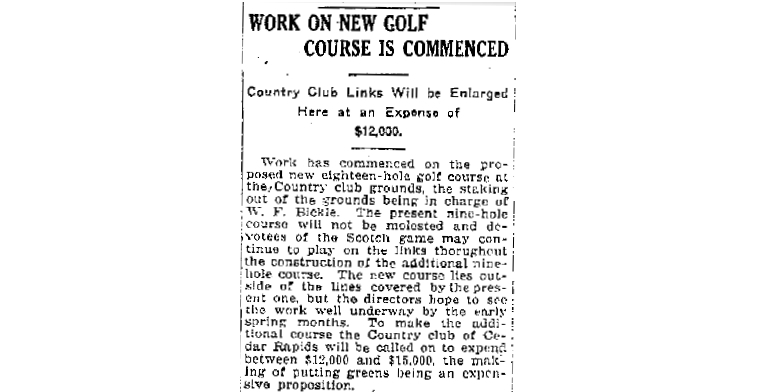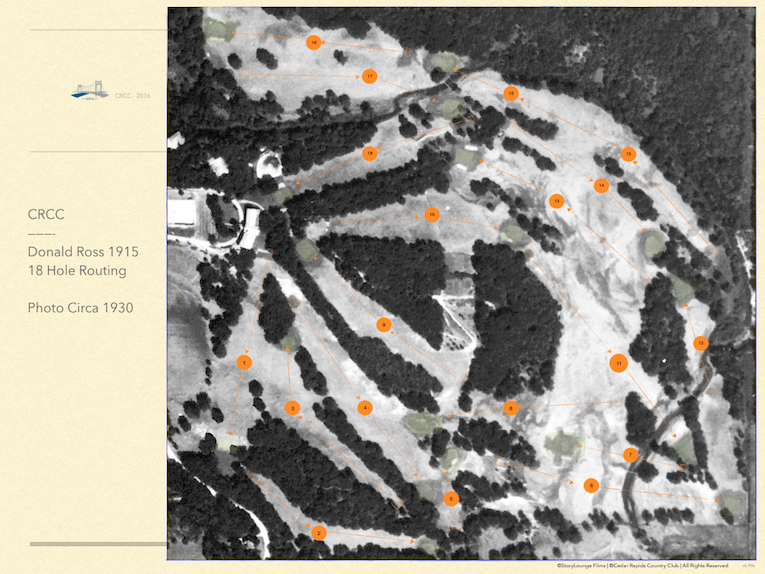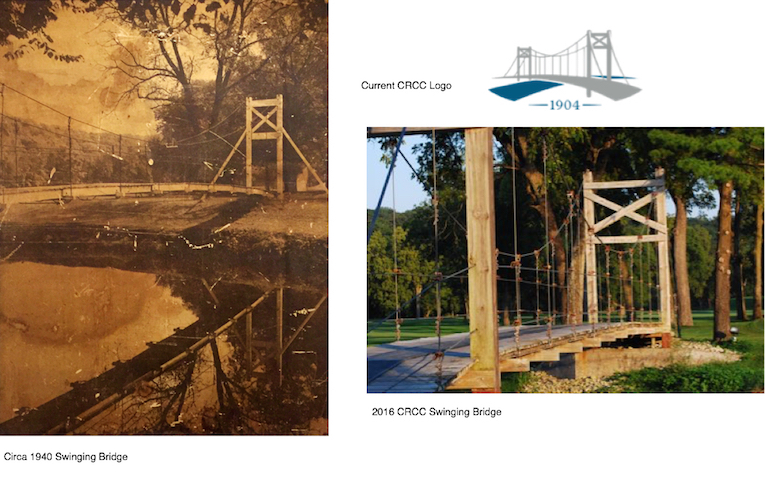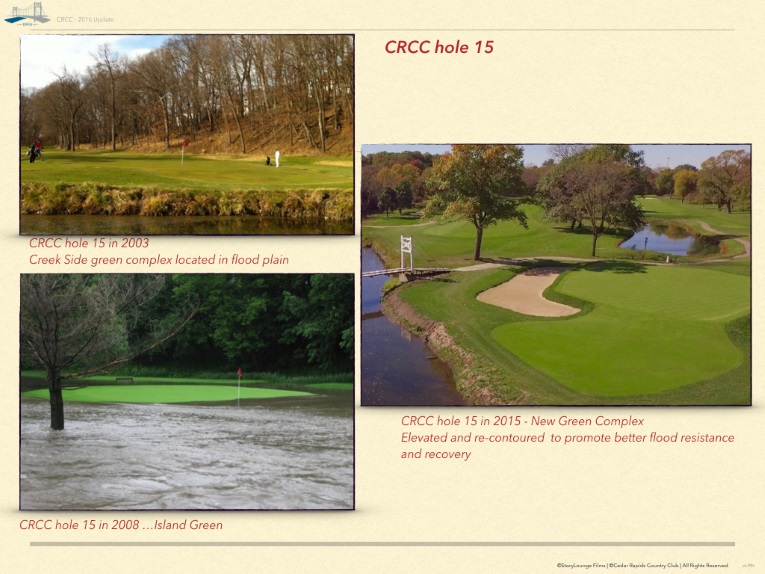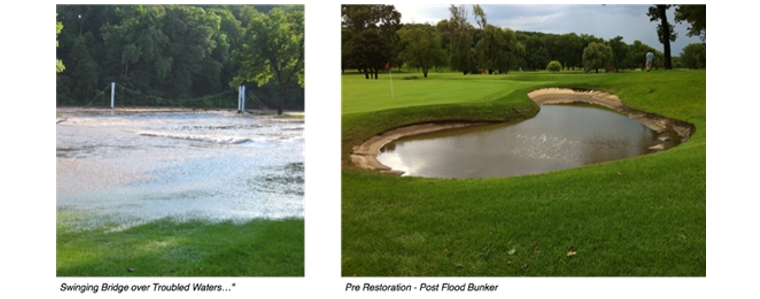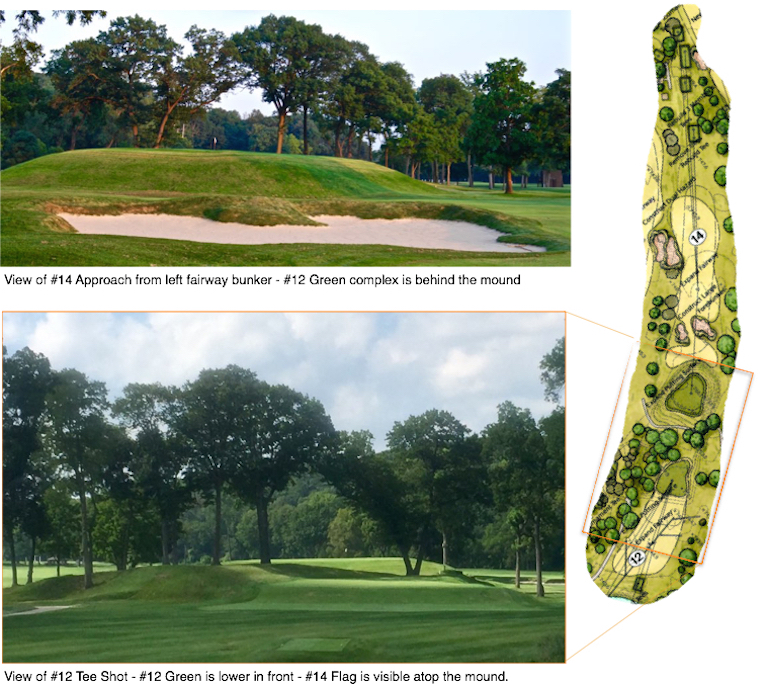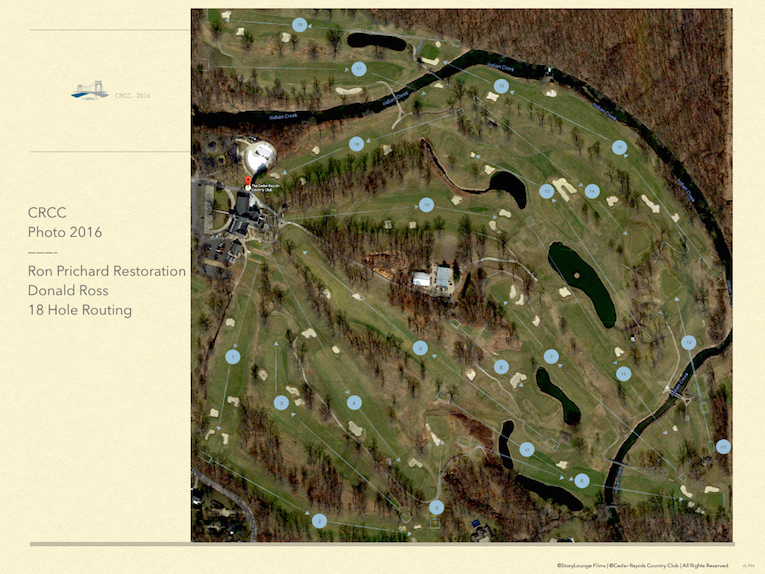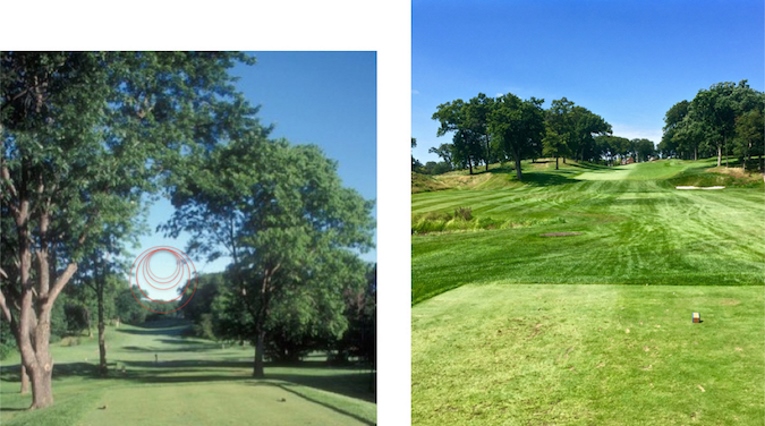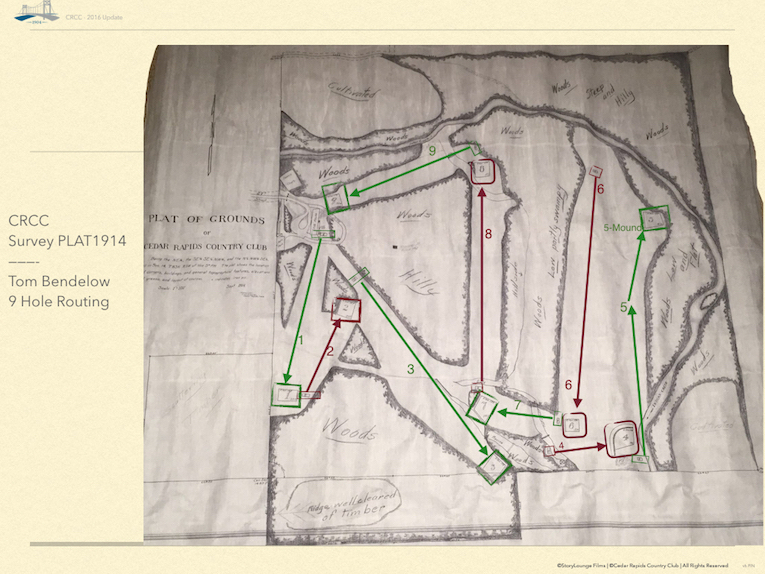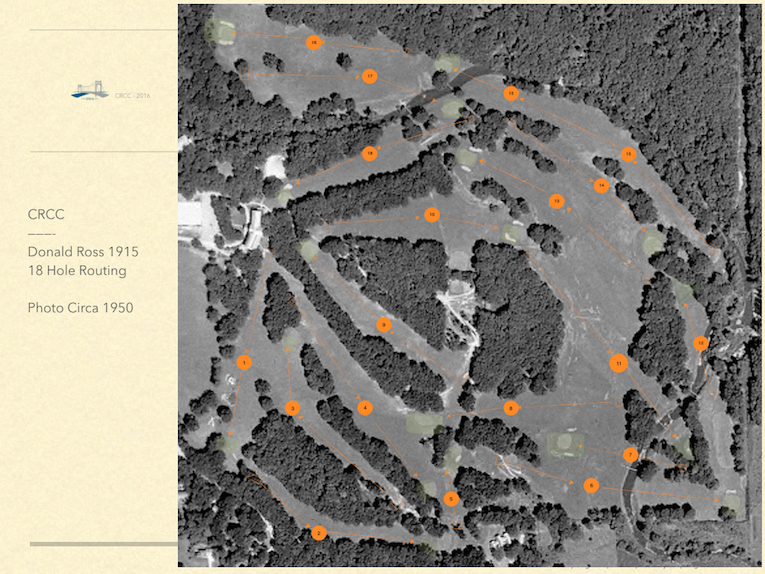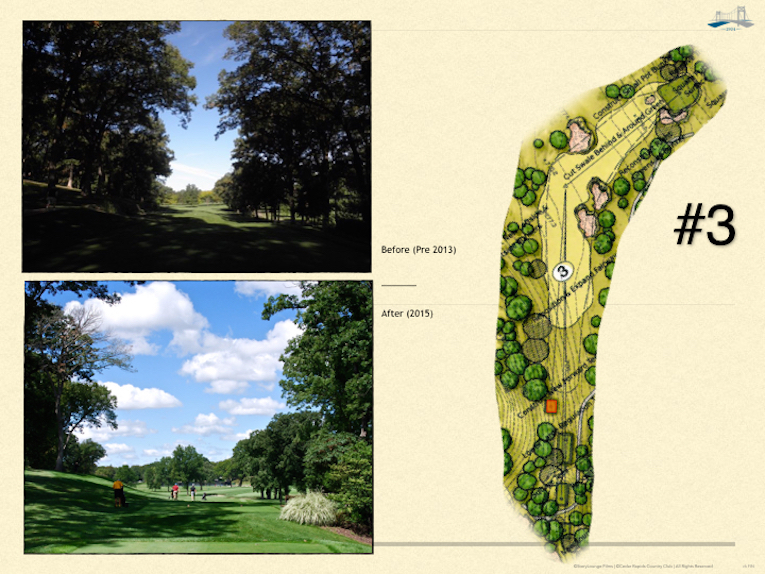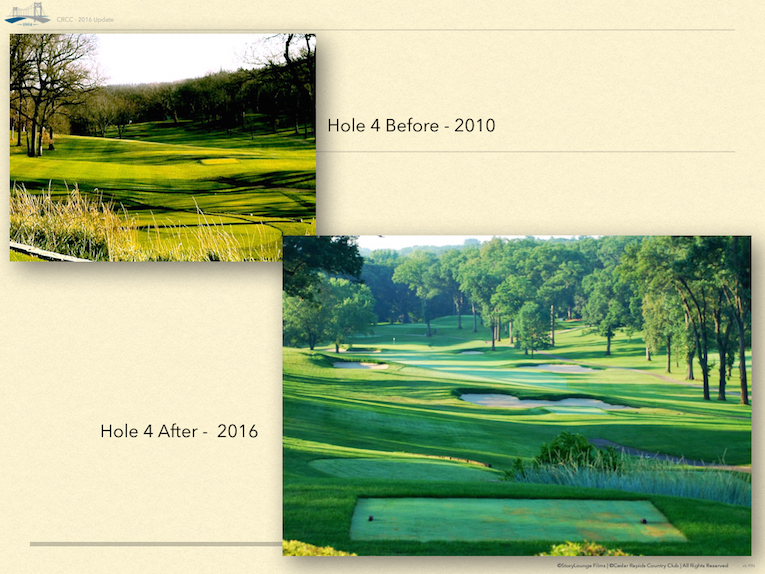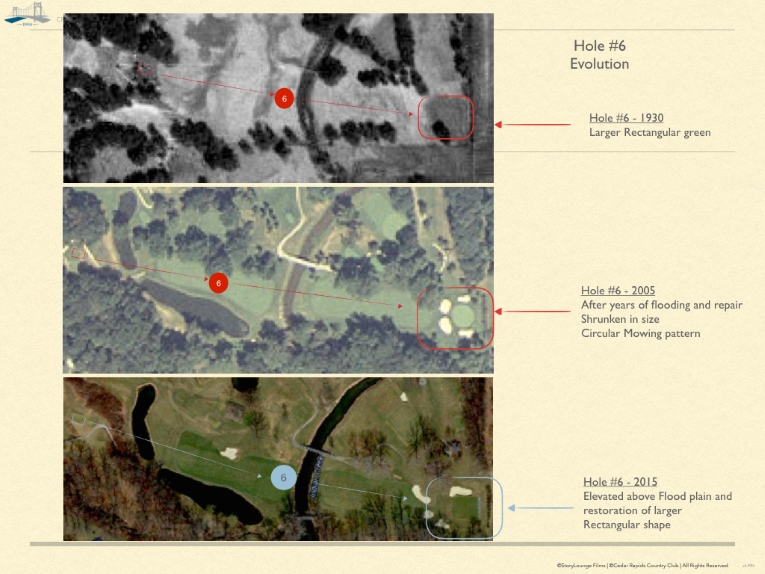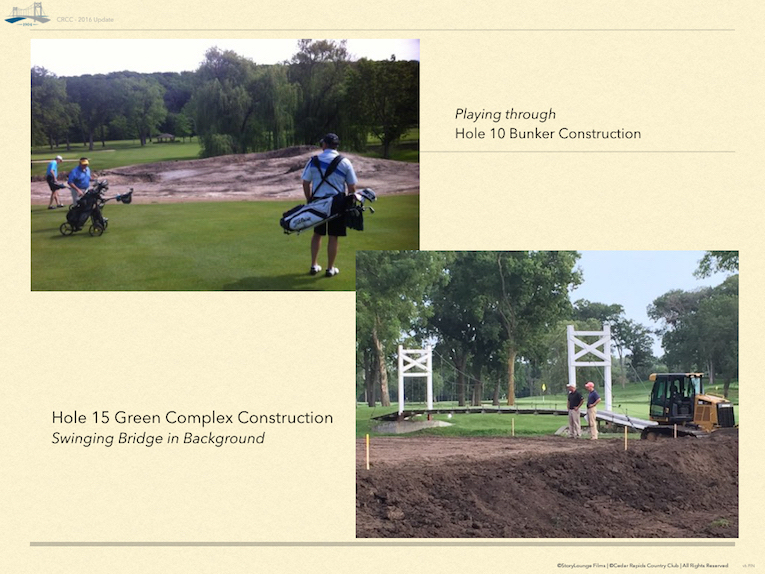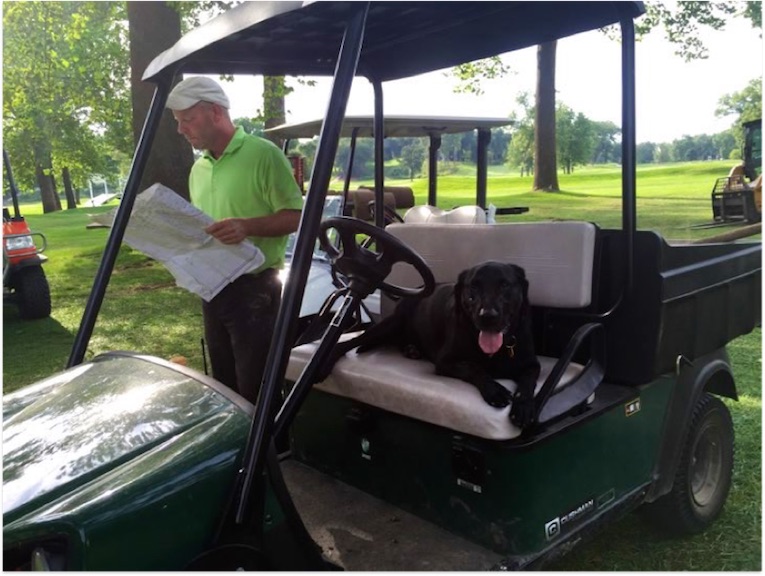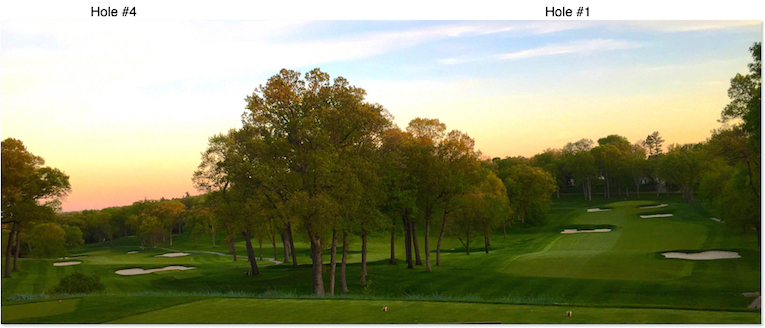Feature Interview
with
Vaughn Halyard
October 2016
Vaughn is the Golf Chairman and a board member at Cedar Rapids Country Club. As such, he was one of a core group of people that helped drive the outstanding Ron Prichard restoration of their Donald Ross golf course. What they accomplished is a celebration of achieving top results at a reasonable cost, something that has been sorely lacking from the American golf landscape for several decades. It is an important story to both understand and from which to learn.
1. Tell us about the architectural history of Cedar Rapids Country Club.
Would love to tell you about it and thank you for the invitation. My day job is running a small firm that tells creative and media stories and this is a good one. Not long ago, the Cedar Rapids Country Club (CRCC) golf course was an architectural mirage. From the distance, the routing and features resembled a Donald Ross course but the image would fade upon closer scrutiny. With the bulk of our restoration complete, the mirage has been transformed into an oasis. It took a significant amount of creativity and heavy lifting but the results have made CRCC members and guests the beneficiaries of a refreshingly authentic, challenging and delightful golf experience in a bucolic setting. Our way is not for everyone. It was not a walk in the park but it was a long time coming. CRCC’s current location is the club’s second. The interest in golf was sparked in 1896 when George and Walter Douglas, founders of Douglas & Co. the precursor to the Quaker Oats Company, returned from a visit to Scotland with golf fever. With their brother Will, the Douglas’ subsequently laid out several fairway-like environs in Judge Green’s low lying pasture near the Milwaukee Road rail main line running north east out of Cedar Rapids. In 1900, sharing the pasture with livestock soon resulted in tee time conflicts leading a group of ten to lease 30 acres on what are now part of the Brucemore Mansion, a National Trust for Historic Preservation site. They built a course that would support more dedicated play with fewer bio-animal hazards.
In 1904, as the city grew, a more permanent location was sought resulting in the formation of the Country Club Land Company whose 96 subscribers raised $15,000. The club’s current location, one hundred eighty acres along Indian Creek, were purchased at $75 an acre accompanied by a five-fold increase in annual dues from $5 year to $25. A larger clubhouse was built in1904 as the Indian Creek adjacent property was converted into a nine-hole golf course with clubhouse. Scottish golf course architect Tom Bendelow, designed that initial nine hole course with the longest hole measured 400 yards. In 1914, the land company exchanged some hilly terrain west of fairway #1, for 36 acres of more level ground providing space for tennis courts.
Of note, in 1920, Bendelow also designed the original 9 holes for Cedar Rapids’ Ellis Park Municipal golf Course. That nine was expanded to 18 holes in 1949 by William Langford. Most of Ellis Park’s Golden Age characteristics have been renovated into submission.
In 1914, Donald Ross was hired to lengthen the course from nine to eighteen holes. It has been verified that Mr. Ross was sent to Cedar Rapids by Ralph Van Vechten, older brother of the famous writer and photographer Carl Van Vechten, to lay out the extended course. He made a site visit to Cedar Rapids during a trip to the west including visits to Illinois, Lakewood and the Broadmoor.
Plans were generated from that trip and there is published verification that Ross came to physically lay out the course in its present location. The plans were received sometime during late fall, November- December 1914 as reported by the Cedar Rapids Daily Republican.
We have not found verification of Ross returning to spend any extended time on-site during construction. Construction were handled by Cedar Rapidian, W. F. Bickel who’s detailed topographical plan of the entire 170 acre site are credited as having been approved by Ross and informed the construction.
Golf Evolution
During the years after Ross’ work, the course experienced an evolution not unlike other golden age clubs. With no master plan per se the course became subject to a progression of historical and natural events. Wars, economics, demographics, management, membership, committees, superintendents, city expansion, zoning and development introduced a myriad of new features and foliage. The usual suspect list of golf trends influenced course alterations. Most of these will not be revelatory to the GCA readership, none the less, collectively, they represent the forces that ultimately forced our restoration.
- The King: Some long-time members have shared that the television and the success, marketing and management innovations led by Arnold Palmer introduced a new vigor to the membership during the 60’s and 70’s. This spawned numerous course alterations in an attempt to mimic courses seen on TV.
- Augusta: The visual perspective of television in Full color broadcasts of the Masters led to the planting of trees to replicate the tree lined fairways and white sand effect delivered by Augusta. Ponds were added in 1975 and tee boxes were reconfigured. During the early part of our restoration, there were some lively member discussions highlighting that the fact that well before 2011, Augusta had taken to removing trees, raising the canopy and increasing air and light access to all of their putting complexes and fairways.
- Tiger Effect: The 90’s and Y2K produced player/celebrity architects, MOI-Driver Face-spring like effect, Pro-V1, carbon fiber shafts, titanium club faces, player fitness and the need to “Tiger Proof” courses that Tiger would probably never see. This plus increasingly intense and frequent flooding led to additional emergency and ad-hoc bunker construction and tree planting to defend the course against mother nature as well as those that would declare themselves enemies of par. Most of us would never pose a threat to par but none the less, we built and planted. The club luckily declined to embark upon a proposed full scale redesign that would have most likely eradicated the Ross features and routing.
- Water and Mother Nature: Since Ross’ visit, Cedar Rapids had expanded well beyond and around CRCC. Our rolling Hill/Valley site sits in the Indian Creek Watershed . Our valley vistas are framed by hills which form a geologic gauntlet that bends at the edge of CRCC. Urbanization of historically rural areas upstream now direct a spigot of increasingly flash flood level events onto the property. Previous to the restoration, when it rained too hard, we closed. Mother Nature and the ghost of Donald Ross issued a clear joint communiqué, “Fix It”.
Water always wins. Our signature man made feature and logo is our “Swinging Bridge”. There have have been multiple swinging bridge crossings and bridge versions throughout the history of the club. The sole remaining swinging bridge connects the #15 and #17 Fairways to their respective greens. During one particularly violent flood, a member watched something float by miles from the club thinking to himself… “Hmmm that looks like the Swinging Bridge…”. That particular bridge was never found and we assume its remnants are spread between Cedar Rapids and the Gulf of Mexico.
The community has worked to improve upstream flood mitigation but a powerful rain can still thrust the creek from its banks. Testament to the efficacy of the restoration, during the writing of this article, the course received a deluge of over 6 inches of rain in 24 hours yet was able to be fully open for play by noon… with carts. Previous to the restoration, the course would have been closed for a minimum of 2 days
5. Infrastructure-Current Day: Although the design and restoration delivers outstanding vistas, classically framed golf holes and lines of play, a majority of the budget and time was spent reconfiguring the course infrastructure to enhance airflow, water management and promote water evacuation during the inevitable flood events. The bunkers have been reconstructed and the swales and fairways now work to move water off of the course faster and more efficiently. This delivers increased enjoyment for members and guests by delivering a drier course and fewer lost days of play. Focused tree management has delivered consistent rough, firmer fairways and healthier putting surfaces free of fungus, mold and excessive moisture. This gives Tom Feller, our superintendent, the ability to tailor and tune the performance of the course. Fast and firm for a U.S. Open qualifier, longer and lush to withstand sweltering hot dog days of extended 90 degree plus summer.
The community has worked to improve upstream flood mitigation but a powerful rain can still thrust the creek from its banks. Testament to the efficacy of the restoration, during the writing of this article, the course received a deluge of over 6 inches of rain in 24 hours yet was able to be fully open for play by noon… with carts. Previous to the restoration, the course would have been closed for a minimum of 2 days.
2. Besides the amazing 14th green what, if any, Bendelow features survive?
The bones of both the Bendelow and Ross routings have been reinvigorated and celebrated by Ron Prichard’s restoration. Prior to the Bendelow routing our current location, the land was an undeveloped mix of woodlands and prairie with a sprinkling of swamp. Ross incorporated parts of the Bendelow course within his routing. As Ross expanded the course from 9 holes to 18, he kept Bendelow’s original first and ninth holes in their entirety. Bendelow hole #9 the became Ross’ #18. Ross rerouted and lengthened hole #2 doglegging it left up and over a hill to the south. He cut a new dogleg right hole #3. This converted Bendlow’s #2 green to Ross’ #3.
Bendelow #5 became Ross’ #14 reversing the direction of the hole presenting the approaching player with a dramatic/intimidating visual and an off-camber putting surface that slopes away from the approaching fairway. Local knowledge will also inform the player that #14 gets baked and wind-polished more than any other putting surface on the property. Ross then utilized the lower part of the sloping mound feature to build and shape the triangular Ross signature #12 green complex and putting surface.
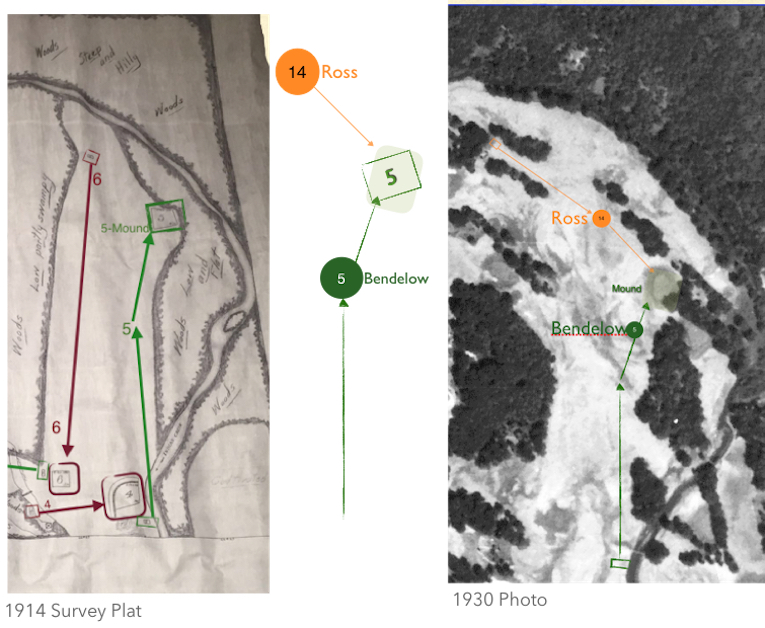 Hole #12 is fairly beloved whereas #14 is a polarizing figure. Simultaneously revered and reviled, #14, aka Burial Mound, receives love letters as well as death threats, some sealed with stickers depicting bulldozers and dynamite . The resultant two-green complex has become a signature feature. The restoration has also made the fourteen green watchtower of sorts with a vista of 10 flags previously obscured by tree overgrowth. Indian creek became a prominent feature of the approach shots on the new #6, #11 and #17. The Creek also comes into play along the right side of #15 and as a crossing hazard to green approach on #15 and #17.
Hole #12 is fairly beloved whereas #14 is a polarizing figure. Simultaneously revered and reviled, #14, aka Burial Mound, receives love letters as well as death threats, some sealed with stickers depicting bulldozers and dynamite . The resultant two-green complex has become a signature feature. The restoration has also made the fourteen green watchtower of sorts with a vista of 10 flags previously obscured by tree overgrowth. Indian creek became a prominent feature of the approach shots on the new #6, #11 and #17. The Creek also comes into play along the right side of #15 and as a crossing hazard to green approach on #15 and #17.
3. This is Ross’s sole effort in Iowa. Do you know if Donald Ross himself was on property? Who was his construction superintendent?
We know that Donald Ross physically visited the property and generated plans during his travels coinciding with the period he spent time in Illinois, Kansas and Colorado. It is not known if he was accompanied by one of his construction associates although, I was told by iconic Iowa broadcaster and CRCC member, the late Bob Brooks that he was told that Ross associate Walter Hatch was on site for some portion of the layout and initial shaping but we have not been able to find any verification. Local engineer W. F. Bickel made a detailed topographical map based on Ross’ plans and is credited with the extensive physical construction of the course. In 1916 CRCC’s President Cyrenus Cole praised Bickel in an article stating:
“Mr. Ross laid out the course out on paper. Mr. Bickel laid them out on the ground… No. 10, was holy his creation. It was a swamp that Mr. Ross skipped. Mr.Bickel proved to me that he could take out the water and kill the mosquitos and where there was a bog there is now going to be green grass- not two blades but millions of them.”
CRCC Clubhouse
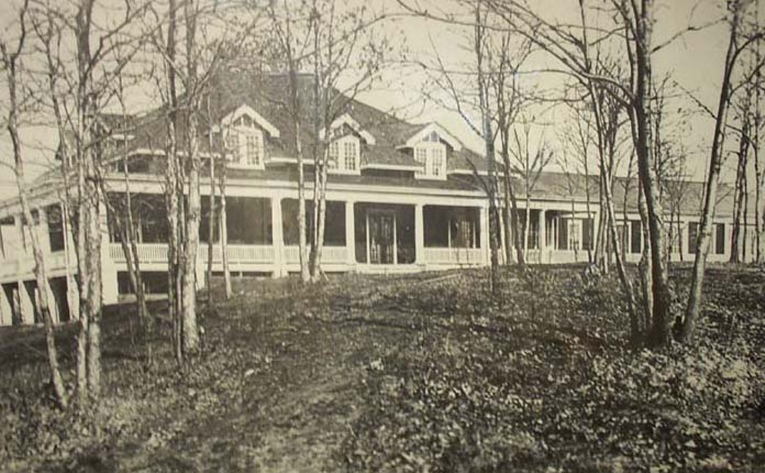
Ross’ initial plans called for construction to be done in tranches, one of which included a bunkering phase. In a community of Golden Age golf clubs, it would be cliché for us to say that those plans were “lost in a clubhouse fire…” The Cedar Rapids Country Club built a brand new brick clubhouse in 1928. replacing the wooden clubhouse that burned to the ground in 1927, which places us in the community of Golden Age golf clubs whose original plans were “lost in a clubhouse fire.” WW1 and the crash of 1929 delayed further bunker and other subsequent course construction projects for decades.
4. What was the impetus for consulting Ron Prichard in 2011?
Need for Restoration and Reinvigoration. The course was fatigued, and had become costly to maintain and greens were unhealthy. The intent of our CRCC project was to reinvigorate appropriate Ross characteristics while simultaneously delivering playability for the modern game. Trees and floods took a toll on the original layout moving it far afield from the original spirt of the Ross design. Historical aerials illustrate that 1970 to 2000 was the most prolific era for tree planting, contraction of fairway and putting surfaces. Additionally, a series of ponds were cut into the property to provide some flood and drainage relief but were not placed in character with the Ross routing.
Floods, Foliage and Father time, drove our need to make soil based infrastructure changes. it presented us with a fiscally timely opportunity to simultaneously address human generated course alterations which included; out of character bunkers, tee box complexes, mounds, trees and circular shrunken putting surfaces. Combining these projects enabled us to cost effectively revitalize Donald Ross characteristics lost or obscured over time. Ron, Tyler and Tom Feller developed a master plan that simultaneously addressed hydro and infrastructural issues and defined the Ross design components. Equally important, the master plan defined a process for future course alterations.
5. How did you select Ron Prichard?
The committees narrowed the field to three finalists who were contacted with Requests For Proposals (RFP’s). Each architect delivered outstanding proposals via presentation to membership and committee. Ultimately it was decided that the approach presented by Ron and his associate, Tyler Rae best fit the fiscal and construction philosophy of the membership and staff. We also sought advise and consul from expert external resources such as Donald Ross expert Brad Klein who was very educative, accessible, informative and instructive with regard to ebb and flow of Ross’ style and influences. Given the nature of our property and the era of Ross’ involvement, the same three or four names kept rising to the top, one of which was Ron’s.
Each proposal was strong. Given that we were already in progress with our flood plain and drainage work, we were enthused by Ron’s willingness to collaborate with our in-house crew. Especially attractive was his intent to utilize the majority of our existing fairway and putting surfaces which significantly reduced the project’s budget.
Ron: “Hey, this grass has survived for 100 years, lets stop suffocating it, give it some light and see how it does.”
6. What became the scope of his project?
Our Project Mission Statement:
Address the soil based infrastructural upgrades, provide the membership with a plan that reinvigorates and preserves the unique characteristics of the Cedar Rapids Country Club golf course and to ensure a fair, playable and highly enjoyable golf experience for modern era golfers of all skill levels.
We had an unhealthy course that had gone to the far side of a tipping point. Ron’s design served all of our golfer/member constituencies. It appeals to the weekend walker as well as our second generation of Tiger/golf athletes. It is designed to handle technological innovation, advanced golf instruction and fitness. Most of our members are hitting the ball farther, faster and more accurately. We are primarily a walking club with members who love a nice walk sprinkled with golf for relaxation and camaraderie as well as a increasingly scoring oriented group of competitive players.
Customer Experience Approach the Restoration
Ron’s design concept was to deliver a course able to attract and support a sustainable level of membership, from the recreational golfer to the contemporary athletic/competitive player. Below is a summary of our scope.
1: Delivery of a fair and enjoyable experience for all membership and handicaps. Correctly placed tee boxes and lines of play are the key to this strategy. Previous tee complexes did not reflect true differences in carry distances. White, Blue and Black tee markers were routinely placed ten paces apart on the same tee box with little relevance to the difference in player capabilities.
2: The restoration would “defend par” not with trees but with appropriately configured tee complexes, lines of play and bunkering to introduce a variety of fair risk/reward opportunities. The result enables golfers of all levels to experience an enjoyable round. The wider fairways, lack of intrusive overhanging trees and limbs, expanded green complexes and putting surfaces have made the course more fun for all. Gone are the “Trunnels” (Tree-Tunnels).
As I shared with one of our USGA U.S. Open qualifying guests: “You don’t need to be super long to go low from your tees (Tournament Tees), but you best bring a dart gun and a smooth putter.
7. What kind of source material from the 1930s existed to help guide the restoration?
In addition to the 1914 Bendelow era survey plat, golf committee and restoration committee member Dr. Steven Greif had researched and located a treasure trove of aerial photographs dating back to the 1930’s. These proved invaluable to the effort. There were some on-course and historical archival photos but the most informative content assets proved to be that progression of aerial photographs including some unique LIDAR images. They enhanced the team’s efforts to locate original surface features including green fill pads and geographic points of reference.
Execution of the tree management plan and Ron Prichard’s design reclaims many of Ross’ open vistas, reestablishes original lines of play, delivers watershed driven infrastructure, green complex improvements and Ross characteristic bunkering.
8. How was the membership approached regarding this project?
– The concept of a restoration was first presented and rejected during the late 90’s. Over the years as the infrastructure and playability of the course showed signs of accelerating deterioration, it was time to take some form of restorative action. The trees were fully encroached on the fairways and the greens were in very poor health.
– The project was re-launched in 2011 by then Golf Chair Jason Haefner. As incoming president, it became clear to Jason it was time to stop making ad-hoc uncharacteristic course changes and short term fixes. The club and committees determined the need for a master plan for the golf course. Simultaneously and thankfully the appreciation of classic and minimalist course design had expanded, construction, agronomy and hydro-sciences improved, the concept was revisited.
– I assumed the golf chair in 2012 and credit much of the heavy lifting to the previous and subsequent club Presidents, Tom Peffer and Haefner who took some fairly nasty arrows yet continued to support and rally a group of members to seed the project and accelerate the construction of a Prichard designed, 3-Hole playing prototype of the course’s most visible holes, holes 1, 3 and 4. This effort was not without controversy but the group persevered and received a majority membership vote of support. This effort jump started the restoration.
– Our mission statement outlined need to make significant repairs to the course and enhance the value of the member experience. The course in the flood plain was functionally broken and it was a good time to define master plan and make the aesthetic improvements. We stayed in our lane financially as the project was not seeking to capture a US Open but did aspire to be the best course in the area and proudly fly the “Donald Ross” flag.
– We embarked on an internal “Road Show”that presented to various interested constituencies including long standing senior golfers, Women’s Golf programming and competitive golfers seeking a more contemporary and competitive golf environment. The presentations included detailed explanation of the reason for restoration, value of investment in the course as an asset, drawings. Many of the slides in this article incorporate elements from our “Road Shows.”
– We also contracted with Best Approach who delivered 18 holes of outstanding architectural plan based animations. The clips delivered effective visualization enabling members to “flyover” each hole before it was constructed. All of these assets were placed behind our firewall so our out of town members could be kept apprised of project progress.
– The effort was informed by various committee and member visits specifically to Pinehurst #2, Interlachen, Winged Foot, Pine Valley, St. Louis Country Club, Chicago Golf Club, Old Elm, The Valley Club of Montecito, Cypress Point, Golden Valley, Riviera, LACC and Shoreacres to expand familiarity with classic golf architecture. These visits served to enlighten and highlight the potential of our classic Donald Ross course. We also played courses such as Skokie, Exmoor, Beverly, Aronimink, and Minikahda, original Ross Courses restored by Ron Prichard.
– These visits illuminated how far CRCC had strayed from a Ross original and our potential for excellence given the outstanding quality of CRCC’s property. The 3-hole prototype launched a number of long needed infrastructural, agronomic and tree management projects needed to return the property to health. Raising the canopy, improved the health of the putting surfaces and restored some vistas as seen by Donald Ross as he walked the property.
– The project was enthusiastically supported by Superintendent Tom Feller who welcomed the challenge to deliver a significant amount of in-house construction.
9. What was their initial reaction?
In 1999, the reaction to a proposed restoration was less than enthusiastic. In 2012, the initial reaction was mixed; 20% enthusiastic, 50% positive, 15% curious and 15% reluctant. As is the case with any disruptive or evolutional change, there were project skeptics. Some key member concerns and results:
Concern that bunkers would increase cost of maintenance
- The new bunkers are more efficient, have better drainage and better and recover better after heavy rainfall. The restoration has reduced lost revenue and increased course availability to membership after and during heavy precipitation.
Concern that tree cutting would destroy the character of the course.
- Photos detailed that the majority of the trees were not present during Ross’ design of the course and many of the residential trees were out of character and injurious to the course and the health of native trees.
- Tree plan has delivered a more beautiful and healthier course
Concern that tree cutting would make the course “Too Easy”
- Result: It has not. The US Open Qualifier winner was +1. Restoration has delivered more enjoyable play across all handicaps.
Concern that the bunkers would make the course “Too Hard”
- They have not made it too hard but we as a membership have had to improve our bunker play. We are blessed with an outstanding golf professional staff and program.
- CRCC 2016: The course is not harder. You will need to play smarter. Our golf programming and instruction will make your play smarter and as a competitor will hone your skills to play harder.
Tree removal would make play unsafe and susceptible to on-course cross fire
- It has not. Tee boxes have been rebuilt and aligned more accurately and appropriately
- The native trees are now healthier as are the fairways, surrounds, green collars and putting surfaces.
Concern that the changes were unwarranted and the course is the most beautiful in the area and changes would effect little or add little value to membership
- For the first time in a decade, we have raised the initiation fee
- We have received our first recognition from a national/global golf publication with Brad Klein’s inclusion of CRCC his 10 Favorite Ross Course list.
- We are pleased to be invited to contribute this article, the first CRCC focused GCA content.
10. How were the obstacles overcome?
Again, it is probably not possible to appease 100% of any membership. Education, information, and over-communication were the tools we used to seek and secure our majority of support. From town halls and USGA presentations on the merits of restoration and aboral strategy, we worked to manage objections with objective third party expert opinion, facts, details and plans.
We strove to address concerns with education and presentation of benefits:
The project’s pitch and sell process did not target a specific group as much as it made sure to inclusively and collectively communicate and highlight key member-relevant benefits.
Some of our key talking points:
Necessity to repair and update the courses infrastructure
- Had to improve water and tree management
- Need to improve health of greens (Via Tree Management)
Opportunity to celebrate our globally relevant Donald Ross brand
- We have historic and championship caliber siblings
- Celebrate our uniqueness as sole Donald Ross course in Iowa
A true Ross restoration will enhance the golf experience across all golf demographics
- Women
- Juniors
- Families
- Senior Golfers
- Recreational Players
Properly executed, the restoration will also challenge the Low Handicapper and Contemporary Long Hitter WITHOUT Penalizing Higher Handicap or recreational players. This was important as this enhanced the viability to attract and retain younger and future members
- Junior golfers and High School Players
- Collegiate Players
- All represent future and legacy members
We hosted multiple expert presentations including those delivered by Brad Klein, Golf Week Editor and author of Discovering Donald Ross: The Architect and his Golf Courses. We held repeated town hall and “fireside chats” with Ron Prichard. Members were never shy about approaching Ron with their “advice” and he would deftly and methodically provide anybody who inquired with the reasoning and logic to his plans and approach. Ron did an outstanding job highlighting the restoration values particularly relevant to CRCC. He also shared great anecdotal and results based examples highlighting the value of member pride of ownership delivered by well executed, classically restored courses.
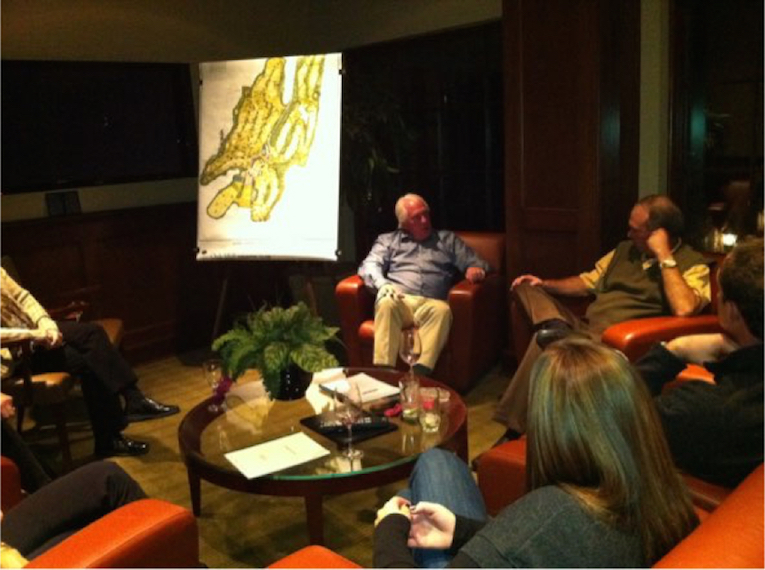
Brad lauded CRCC members on their bold efforts and humorously reminded CRCC membership that when he first presented to CRCC around Y2K, he was heckled off of the property as a heretic for proposing such absurd alterations.
11. What would have killed the project? Whose support (apart from the membership’s) was absolutely integral for proceeding?
Committee edification was essential. We had to learn what we should know which informed what we should do. In our case, doom would have faced any project that failed to address needed infrastructural changes. We formed a specific Golf Course Planning committee to define the necessities, research the possibilities and narrow them to the plausible. Prior to pitching a restoration, we identified the essential infrastructural needs. Three options were presented to our membership at large.
We informed members of the course’s essential operational needs that also supported aesthetic opportunities. We worked to identify member value to be delivered by a historical and authentic restoration. Ultimately, a majority of membership recognized the value of the restoration based on a phased fiscal and operational approach. Levy of a significant assessment or dues increase would have killed the project. Also, given our April to October season, proposing a 100% course closure might have also scuttled the project. CRCC is an in-town club with local membership in contrast to a destination, national or resort course and membership preferred disruption rather than closure. Some members play the course 5 times per week. Closure was a worst case scenario to be avoided if possible.
Superintendent buy-in and involvement in the definition of the scope was essential. Our process was fully collaborative with the golf superintendent staff. The prototype and phased approach enabled continued member play and the opportunity to experience the improved conditioning, aesthetics and golf experience. Any presentation of a scope that failed to address all of the club’s golfing demographics would have lacked support. The scope of work addressed improvements for the full membership
- Women and Senior Golfer constituents benefit from re-aligned, more fair and more representative tee boxes and lines of play ultimately enhancing their member golf experience
- Low handicap Golfers benefit from re-aligned and lengthen tee shots representing a nationally competitive environment.
- Restoration provided our superintendent with improved course management environment and
- It provides our new golf professional with an outstanding canvas for programming and education
- Junior golf benefit from a more appropriate tee boxes plus a reinvigorated and nationally competitive golf programming
- The club membership at large benefits from the increased recognition of the unique Donald Ross offering via increased membership, participation and it places our small midwestern course into a national conversation based on excellence.
The course has two fairly distinct environs, a “hills” and a “valley”. The valley part of the course sits in a flood plain so the construction of both the fairway adjacent swales and new bunkers have been strategically designed to evacuate water from inevitable floods. We are realizing tangible efficiencies and operational ROI with the new bunkers whose construction delivers better drainage and reduced maintenance. We will continue to expand planting of fescue and other appropriate native grasses.
12. Tell us about the bunker style utilized.
Ron defined our bunkers based on the current geology, geography and topography framed by the period of time Ross would have constructed the bunker. Ron and Tyler were extremely educative and informative that Ross was a perpetual experimenter who’s style and construction tastes evolved over time. Based on the earthmoving capabilities of the era, CRCC bunkers are “early traditional” and appropriate for a 1915 Ross design. They have been fairly simply built:
1- Soil was cut to create a simple basin area
2- Drainage materials lined the base with minimal tiling for water evacuation.
3- Resultant soil fill materials were heaped up to form the defensive back shoulders.
4- Swales were fashioned to deflect potential water from flooding the bunkers and evacuate runoff away from the bunker borders and floors. We are now in a detailing phase focusing on approaching surfaces, facing, edges and borders as well as fine tuning various restoration items.
The course has two fairly distinct environs, a “hills” and a “valley”. The valley part of the course sits in a flood plain so the construction of both the fairway adjacent swales and new bunkers have been strategically designed to evacuate water from inevitable floods. We are realizing tangible efficiencies and operational ROI with the new bunkers whose construction delivers better drainage and reduced maintenance. We will continue to expand planting of fescue and other appropriate native grasses.
13. How much putting surface was recovered in terms of square feet?
We shared the fate of many Golden Age Pre-Depression era courses. Our once expansive and asymmetrical putting surfaces had succumbed to “rounding” and shrinkage from “efficient” circular mowing patterns inherent with tri-plex riding greens mowers. Additionally, a number of our putting surfaces had been suffocated by years of significant tree overgrowth.
Over the course of our 3-year restoration, Tom and his crew delivered a meticulous expansion and reclamation of roughly 17,000 square feet of putting surface. The reconstruction of the putting surface complexes for #’s 6, 15 and 16 elevated those putting surfaces and bunkers out of the flood plain and added an additional 5,500 square feet bringing the total to over 22,000 square feet of additional putting surface for the 18 holes.
We consulted with and heeded a USGA Turf Advisory Service recommendation to remove all residential-style trees that have been planted in such great numbers that they don’t have adequate space to fully mature as well as remove all the trees that are planted to the east, south and west of all putting surface complexes so the turf can receive adequate sunlight and air flow. Tom worked with a certified arborist and based on their recommendations to the Restoration and Golf Committees, his team embarked on a well-planned tree management program. Once putting surfaces had access to airflow and natural sun light was restored, we embarked on a fairly expansive green/putting surface and surround reclamation.
We were fortunate to have identifiable physical points of reference, photographs and soil cores allowing the team to identify or verify many original putting surface fill pads. All were evident and recoverable save for #6, #15 and #16, which had been flood decimated precipitating fairly indiscriminate reconstruction over the precedent 97 years. The bunker and green complexes were rebuilt and raised above the flood plain and fitted with improved drainage. Most of CRCC’s putting surfaces had lost a significant amount of their original size, character and shapes. Hole #12 serves as a good example where close to 40 feet of original putting surface dimension and depth was reclaimed returning it to its original triangular shape visible on the 1930 overhead photo.
Fairway expansion
Our arbor management program reclaimed roughly 35% of additional fairway width across the board yielding an additional eight acres of fairway. The improvements are palpable and the member playing experience has been exceptional. It is physically and experientially a new course. Every key component of the course is healthier, the putting surfaces, the bunker complexes, the rough and the fairway are all in significantly better shape.
 14. People familiar with the project tell me you got a $3,000,000 outcome for ~$700,000. Please walk us through what you did to achieve such results!
14. People familiar with the project tell me you got a $3,000,000 outcome for ~$700,000. Please walk us through what you did to achieve such results!
I would love to say we were prescient enough to say we planned to deliver a $3,000,000 restoration for a number in the $700k ballpark but that would be a fallacy. We had Tom Feller. We expected to have to spend more but didn’t have member approval. We all knew this was a multi-million dollar project that would have to be phased over a longer multi-year period of time. Again, our way is not for everyone.
Ron and Tyler worked in tandem with the Superintendent, Tom Feller, to design the Master Plan. Initially, the process called for Ron to design and draw the new green/putting complexes and surfaces, fairway expansions, bunkers and tee complexes. Tyler would then shape the new bunkers and greens complexes, with Tom and his crew finishing all of the loose ends including: irrigation, tree removal, fairway and putting surface expansion all with current staff.
Tom was also able to phase the work without closing the course while maintaining the regular maintenance routine over the course of multiple seasons.
15. How were you able to accomplish so much of the revision in-house? I assume in large part it is based on having a very talented Green Keeper?
It would be an ardent task to replicate our success. We should clarify that we worked in partnership with Ron and Tyler with Tyler performing a significant amount of the shaping. The overall construction project was managed in-house by and significant credit goes to our superintendent Tom Feller who is a resource, operations management a logistics magician. He figured out how to do a $3,000,000 project for a fraction of that than a which is more truthful and frankly more impressive than saying we gave him less than $1 Million and he made it go as far as he can. He came in 65-80% under budget and probably 2 years ahead of schedule.
Our approach is not for everybody. Not all clubs want everyday operations disrupted by a restoration construction project. Our restoration dovetailed with some very pressing course infrastructural repair needs. Tom calculated that we needed to do a bunch of digging so we might as well take care of the aesthetic needs. We have a pro-active, topically current and R&D oriented superintendent working in true collaboration with the architectural team. Based on budget, our deal with Ron and Tyler was built around consultative design with much of the larger general earth moving and construction to be handled in-house by Tom and his staff. It is of note that Tom and his staff was able to keep the course open for play throughout the restoration.
16. What didn’t you waste money on (that perhaps other clubs have done in similar situations)?
Our relationship with Ron, Tyler and our Tom is probably not easily duplicated. A number of things alined enabling our outcome. Ron met Tyler while working on Barton Hills CC in Ann Arbor, a project precedent to ours. Tyler is a master with a bulldozer, who shapes in sync with the mind of the architect. Additionally, he is a low-handicap golfer who also shapes with the touch and nuance of a player. The symbiotic relationship between Ron and Tyler solidified just as we were beginning our project, very much to our benefit.
Research and detail the scope. We researched and defined a realistic scope of work. The project scope should define the architect. Realistically, we weren’t seeking to host a major. Our path was determined by an immediate need to repair our aged and weathered course in a flood plain. That was coupled with a desire to recapture the course’s heritage. Our modest budget defined the scope. Presentation of a bid with an integrated construction fee would have probably killed our project.
We luckily didn’t have to “blow up” our greens. Not having to re-grass eighteen fairways and greens was cause célèbre. Ron’s meticulous inventory and evaluation of our existing fairways and putting surfaces and the ability to incorporate original fill pads into his restoration plan saved us a significant amount of expense. There were three greens that required complete reconstruction; #6, #15, and #16. Those were raised out of the flood plain re-incorporated Ross characteristics lost to a history of flooding.
17. What have been the results of the restoration in terms of rounds and revenue?
We have grown the game.
The project parallels a Ross philosophy we learned via research, trial, error, history and education with Ron, Brad and others. I’ll cite two GolfCourseArchetecture.com passages from the interview with Ross Documentary film maker Cob Carlson that capture the spirit of our restoration:
1. “There is no such thing as a PURE Donald Ross course. His design style was constantly evolving and adapting as the game of golf was changing.”
2. Question: A constant theme is that a Ross course can test the best while providing fun for the rest. The same can’t be said for most architects – where do they go wrong?
“Simple. Designing courses that were too penal, for both the good player and the average player. The penalties we suffer? Pinched in fairways, abundant water hazards, forced carries over hazards, bunkers across the entrances to greens so that you have to fly everything in, all four par threes over 175 yards long, parallel fairway bunkers, and double penalizing designs…i.e. hit the ball in a fairway bunker and still have to fly it over a tree to recover to the green.”
Cob Carlson – https://golfclubatlas.com/feature-interview/feature-interview-with-cob-carlson-october-2014/
CRCC Revival
Both of these philosophies are core to our restoration. Ron, Tyler and Tom have channeled the spirit of Ross resulting in our current situation, we are having a ball. We could put up a tent in the parking lot and hold a golf revival meeting save for the lack of room for enough cars let alone a revival canvas.
The completion of 90% of our course restoration coincided with the 2015 arrival of Head Golf Professional Dustin Toner, providing him with a canvas to reinvigorate all golf programming. Member rounds played have increased well over 200% from the previous year. He and his staff have increased member and guest participation in programming also north of 200% and Junior Golf participation has experienced a positive 3 digit percentage that defies recitation.
We have reduced the number of outings and in-town resident guest days and experienced double digit new member recruiting growth in our small market. New “national” members have joined based on their work and travel to the area based on the quality and uniqueness of our restored Donald Ross Course. Outing and unaccompanied guest fees have been increased yet neither has slowed demand to gain access on the schedule.
Depending on tees played, the restoration delivers a more fun, fair and challenging golf experience. We have widened fairways, shortened the more forward tees while adding teeth to the low handicap player experience. We have removed a number of uncharacteristic double jeopardy locations such a poorly placed pond between #7 and #11 and green side bunker on the par three 8th.
Most importantly, all sectors of the golf membership are actively enjoying the result, pridefully playing and showcasing the course to friends family, clients and guests, playing a historically unprecedented number of rounds. When a male attempted to speak for “Women Golfers” intimating the bunkers were “Too hard” for them, the women of CRCC golf delivered a variety of fairly “direct” and in some cases, unprintable responses. One of the most poignant and humorous seemed to quell the conflict: “… don’t speak for us, play your own balls…
The new course has been the recipient of numerous gratifying, humbling, heartening and overwhelmingly positive accolades. This also happened one in April of 2016. A guy casually strolls into the pro shop.
“Hi, I’m passing through Iowa on a trip from Minnesota to Des Moines to see a friend and heard about the good work happening here… Tom Doak by the way, I’m a golf course architect. Can I get a tour?”
Ron was resolute and very clear. One of his project objectives was to have CRCC members experience a pride of ownership and sense of play in our restored course. That pride and enjoyment is evident in droves.
For the first time in over a decade, we have increased our initiation fee.
18. What remains to be done? Is anything on your wish list?
The restoration is young. We will continue to detail the course with fescue and we expect to work with Ron to tweak bunkers and putting surfaces. We will add a couple of bunkers per the plan including a pot bunker on #3, some mowed “Hogan’s Alleys” for walkers, and we will continue with the tree management. We will continue to tweak the water dispersal via swales and bunker facings. We are fairly lucky as there a minimal number of structures or roadways adjacent the property. The few there are tasteful and fairly unobtrusive. We will address the need for some visual border along the back of the #6 green to visually frame the hole.
We have removed most of the 60’s and 70’s era cart paths and will find more natural surfaces for areas that need to provide cart traction. For fun, we are exploring ways to deliver some additional Bendelow routings if they can be delivered without disturbing the integrity of Ron’s design.
Popularity and increased play highlighted a need to expand the Par 3 tee boxes and increase the retention length of seasonal staff. Historically, the CRCC high season was informally bracketed by Memorial and Labor Days. We now play from most reasonable thaw to first snow necessitating a reconfiguration of staffing, machinery, agronomy and other resources. We are tweaking budgets based on success that has manifested in a significantly higher volume of member and guest play.
The results:
Over half of the project budget attacked long standing infrastructural, agronomic and flood plain problems. Addressing those problems provided us the opportunity to bundle the delivery of an aesthetically outstanding and authentic Donald Ross experience as part of the long term plan.
The course is healthier, drier, more fun and more efficient. We have added new members and rounds are up over 250%. Our committee is reviewing more member event requests than we have availability, operational costs have been reduced and our geographic membership footprint has expanded. Overall, the investment has been good for business. We have grown the game.
19. In conclusion, what advice do you offer clubs considering restorative work? What should they focus on and what should they avoid?
Our approach is not for everybody and Lady Luck played a big part.
Every situation is different. It was important for us to accurately gauge staff interest, timing, skill-sets and operational capacity to undertake this type of job semi-in-house without disruption to general operations. Tom’s staff and the committees defined the strategic, operational and project needs, capabilities and HR interest of those tasked to deliver the project. In our particular case, it made sense to bundle the repair and restoration.
Research
Know the history of the course. We tried to talk with long time members, old caddies, legacies. We looked at old plats, maps drawings and since we are members of the Club of “Burnt Plans”, we scoured historical societies and other sources for drawings and information. It is key to have a working and anecdotal knowledge of the club. This informs planning, construction and the establishment of a historical narrative. The more complete the history or legend, the more people will become vested in the restoration of that legacy.
Caveat
If an organization were to choose this path, management and staff must be configured to deliver the work within an economical time frame and without degradation of services. If that is not the case, the project budget needs to support construction outsourcing. Our phased project window, staff desire, modest budget and the vagaries of our market defined our process. The objective was to fix the broken bones and deliver a restoration befitting the sole Donald Ross in Iowa. Our budget was dependent on significant in-house construction.
Those closely involved need to drink the restoration Kool-Aid. Gotta’ believe. Project committee members and principals need to believe in the project, be informed and educated, and be prepared to evangelize with facts and details. It is neither for the thin skinned nor those seeking vanity committee posts.
- We never expected to, nor achieved 100% member satisfaction but did attain a very high majority of member support to proceed
- We made a detailed and meticulous component inventory of the club’s golf assets strengths and challenges.
- Positives:Classic architecture, Outstanding setting
- Challenges: Flood Plain, significant unmitigated tree growth, shrunken fairways and putting surfaces
- Our project strove to educate and communicate with membership via frequent updates and presentations
- Clearly defined project mission and realistic anticipated outcomes, E.G.:
- Repair the course rather than continue to apply band aid fixes
- Restore authenticity
- Enhance playability for all member golfers
- Host regionally appropriate marquis USGA caliber events
– “No dues increase to pay for this”
- Research architects aligned with club mission and economics
- Develop an RFP based on the above
- Continue to socialize, communicate and involve the members throughout the process
- In evaluating potential architects, we consciously narrowed our focus to those whose portfolio and vision aligned with our parameters and budget.
- We interviewed candidates with the objective to identify a partner in sync with our vision (and budget)
Let the architect architect. Every club, ours included, has resident experts, great players and long time members with opinions and biases ranging from well informed to less well informed. Recollections of tee placements, tree plantings and long lost green locations vary in accuracy. We were blessed to have Ron who would listen and formulate outstanding responses to the plethora of “suggestions”. Sometimes, he incorporated a suggestion reminding us, the course is never “done”. Member play, time, the course itself and Mother Nature will continue
- to present us with things needing adjustment.
- Plan for the success. We celebrated our completion with enthusiasm, programming and a club grand reopening. We invited Ron, Tyler, local golf and others connected with the project to a 2-ball outing and cocktails. Member, internal and external feedback and recognition has been overwhelmingly positive.
- There Will Be Blood. Accept that you can’t please everybody, change is hard. My predecessor took some IMHO unacceptable heat for making tough decisions to the benefit of the club. To a lesser extent, I’ve overheard people in the locker room say “I hear Vaughn’s killing more trees”. Ha, that’s ok, I came up through technology, music and film so country club cat fights are pretty tame in comparison. One thing currently saddens me is a tiny group of members who have been overheard bragging that they don’t fix divots or rake bunkers out of protest to the changes. Unfortunately, they play a consistent tee time yet to brag about it in a small town and think that we don’t know who they are. Its disrespectful and somewhat infuriating to the golf staff, dues paying member-volunteers and the majority of fellow members that have worked exceedingly hard to make the club an outstanding and enjoyable environ. These are petty responses to first world problems but I am disappointed that we have somehow not been effective in communicating the value of the restoration to this constituency.
Thank you Ran and GolfClubAtlas.com for your interest, recognition and invitation to share insights regarding our project. I would also like to thank Chris Buie for your tremendous research support, which has further enriched the accuracy and vibrancy of our Donald Ross history. Of course as a member of a Donald Ross course and a media professional, I urge readers to acquire Discovering Donald Ross by Bradley S. Klein and The Life & Times of Donald Ross by Chris Buie to be released later year. Both Chris and Brad have been sources of tremendous support.
I am lucky, pleased and humbled to be in a position to recount the excellence delivered by the vision and collaboration of my fellow CRCC members. In golf circles, It was a bold move for a reserved membership. This article was made possible by the research, active project leadership and execution of Tom Peffer, Mike O’Donnell, Ron Prichard, Tyler Rae, Brad Klein, Ken Kinsey, Bill Barnes, Ken Brown, Bill Munsell, Kathy Brown, Molly Altorfer, Dustin Toner, Steve Greif, current CRCC President Anne Parmley. A most special thanks and recognition of the intestinal fortitude and level headed pragmatism shown by Jason Haefner and to the indomitable genius of the undefeatable Tom Feller.
We have a meticulously restored Donald Ross course in Cedar Rapids, Iowa and it would be very difficult for us to be more pleased with the outcome. The restoration exceeded expectations to the point where it arguably may have surpassed the imaginings of “what could be”.




